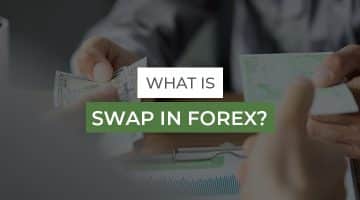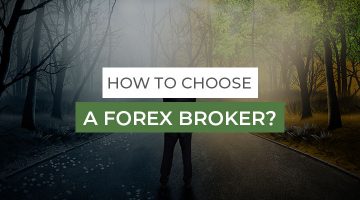Bid and Ask Price Explained

In this article
Like other financial markets, forex has a bid and ask price. These prices update in real-time and reveal the current situation of the forex market.
If you are scratching your head about what we are talking about, then don’t be.
In this guide, we will explain the forex bid and ask price and why they are important.
First, let’s define them separately.
1. Ask price
The Ask price is the minimum price you can sell a forex pair. It frequently changes, as do all other prices on an exchange, as traders respond and make moves. As a result, the Ask price is a key indicator of a pair’s value.
2. Bid price
The bid price is the highest you will pay to go long for a currency. Prices can change quickly as you and other traders act across the globe. These actions are called current bids.
Bid price and ask price example
To understand the concept of bid and ask, let’s assume you visit a phone dealer.
You like the one phone and inquire about the price. The dealer asks for $1000.
This means that the phone dealer will sell you the phone at a $1000 asking price.
Let’s say you want to trade your current phone. The dealer bid price was $500. This $500 is the current bid price dealer will buy your phone.
Your forex broker is like a phone dealer that lets you have a bid price and ask price.
Now that you know the bid/ask concept, let’s explain this with a forex example.
The red block you see is the bid price. This is the price at which your forex broker will buy GBP/USD from you.
The blue block you see is the asking price. This price illustrates your broker’s willingness to sell you GBP/USD.
There is one more thing for you to understand. When we talk about the forex bid/ask price and mention a certain currency like the GBP mentioned above/USD, we’re buying British pounds and US dollars.
Buying a currency means that you use the second currency–a base currency- to buy the first currency in the pair.
The bid and ask spread
There is a term that you need to remember when understanding bid prices and ask prices. This term is a spread. According to basic trading terms, it is the market maker’s profit as it benefits them.
The bid/ask spread, or the bid and ask spread is the difference between the bid price and the Ask price. For example, the difference in price between someone buying a currency and someone selling a pair represents the bid-ask spread.
As the forex uses a pip for the measurement, the Bid and Ask spread has a pip value.
The Bid and Ask spread acts as a transaction cost. You’ll pay a slightly higher price when you buy a pair than the broker’s current price.
Similarly, when you sell a pair, you’ll get the lowest price than the broker’s quoted price.
This is how your Forex market maker generates money. They profit by selling the currency to you for a higher price than they purchased.
They also profit by purchasing the pair from you at the lowest price they will receive when selling it.
There is a reason there is a gap between bid prices and ask prices in trading. Bidding prices are typically lower, and asking prices are higher. For example, the GBP/USD currency pair could have a bid price of 1.4050 and an ask price of 1.4052. The difference of 0.0002 is referred to as the bid and ask price forex spread of two pips. And it is these two prices that produce profits for your broker.
To summarise, traders and brokers always negotiate in a big order to set beneficial rates. The price must be as high as possible for one side and as low as possible for the other.
Bid and ask prices and forex trading sessions
We are all aware that the forex market is a global market with many trading sessions. They are; Sydney, Tokyo, London, and New York.
The Bid and Ask spread for a currency might change based on the trading session. For example, the Bid-Ask spread will often be the smallest during the London and New York sessions, as these have the highest trading activity.
However, a three-hour window occurs immediately after the New York session closes and before the Tokyo session opens, during which the spreads can be important. This is especially true for some currency crosses and exotic currency pairs but can also affect major currency pairs.
Although the Sydney session begins immediately after New York ends, it is not nearly as liquid as the New York session and produces far wider spreads. Volume does not pick up until three hours later when Tokyo comes online, and most spreads return to normal.
Keep this in mind if you intend to trade within these three hours.
Regardless of the trading session, you should always verify the Bid-Ask spread before placing a trade.
Using Limit Orders
It is important to note that bid represents the demand, while ask represents the security and supply. A market order started by an active investor or trader is typically bought at the current price and sold at the current bid price.
A limit order allows investors and traders to place a buy order at the buy price to get a better fill. Ask prices are always higher, so we can assume this will always be the case. Sellers receive a payment equal to the bid price when a Forex exchange facilitates a trade; buyers pay the lowest ask price.
Is the bid price the premium?
An acquirer must offer an additional amount above the pre-bid share price to successfully gain a company.
When multiple buyers compete for the same asset and start placing bids, it is called a bidding war.
Traders who place bids don’t always get the shares, contracts, or lots they want when they place their bids. A market requires both a buyer and a seller, so someone must sell to the bidder for the order to be filled and the shares to be delivered to the buyer.
Is bid sell or buy?
When a buyer buys a specific number of currencies, the bid represents the highest bid price he will pay. Penny stocks are sold at their lowest price at the ‘ask’; this is the current price at which the seller will sell them. In almost all cases, the bid price will be lower than the asking price or “offer price.”.
There is a relatively small average size of s in the major FX spot markets, reflecting their high efficiency. To calculate the value of a pip, multiply the volume traded by.0001. An investment’s tick and pip units illustrate the most basic price movements.
The spread or bid
The term asking price refers to the lowest price a seller will sell the currency. Depending on the security and the market, bid-ask spreads can vary widely. Two-way quotes provide a more comprehensive picture than the last price; they reflect bids, asks, and last prices.
It is common for the bids to reload when sellers try to take out bids, but new bids keep arriving to hold the price. So, if a security is currently priced at $5.05, and a limit order is placed to sell it at the selling price of $5.10, then the sell order will not be placed until someone pays a potential price of $5.10.
Not many trades occur when the bid price is much higher than the current ask price.
What does it mean when the bid and ask are close together?
A trading currency usually has plenty of liquidity when the bid/ask price moves very close. A security with a “narrow” bid-ask spread is said to have a narrow spread. According to Investopedia’s financial review board, when investors have large positions, this situation makes entering and exiting their positions easier.
Alternatively, securities with a “wide” bid-ask spread-those whose bid and ask prices are widely separated-can take a long time and be expensive to trade.
How are the bid and ask prices determined?
The market forces set the bid and ask prices. Their value is determined, in particular, by the actual selling and buying decisions of the people and institutions investing and staking their own capital in that security. A gradual upward shift in the bid and ask prices occurs when demand outstrips supply.
If supply exceeds demand, the bid and asks prices will drift downward. As trading activity in a security increases, bid-ask spreads narrow, and vice versa. A widespread is a fairly good indicator showing a low activity level.
Key takeaways
- The bid price is the highest price buyers will pay for a currency pair.
- The ask is the only price the seller will sell it.
- The Bid-Ask spread is the difference between the bid and asks the price. In the FX market, they represented this spread as pips.
- When you’re buying, you’ll pay what the broker’s asking for the currency; when you’re selling, you’ll need to accept the broker’s bidding.
- Forex brokers make money from spreads.
Bottom line
When entering and exiting a position, most forex brokers, but not all, demand you to pay the spread. As a result, forex day traders or scalpers look for forex brokers with low spreads.
Consider the Bid-Ask Spread to be a hidden trading cost. It can work against you if you have to pay it all the time, but it can work for you if you choose your entry points correctly.
Jason Morgan is an experienced forex analyst and writer with a deep understanding of the financial markets. With over 13+ years of industry experience, he has honed his skills in analyzing and forecasting currency movements, providing valuable insights to traders and investors.
Forex Content Writer | Market Analyst
Relevant Posts

What is Spread in Forex?
[top_three_brokers] One of the most fundamental topics is knowing what is the Spread in Forex?…
Read more

Pending Orders vs Market Orders
[top_three_brokers] An order is an offer sent through your trading platform to open or close…
Read more

What is Hedging in Forex?
[top_three_brokers] Hedging in forex is a common feature for many trading accounts provided by brokers.…
Read more

What is Swap in Forex?
[top_three_brokers] Have you been looking at opening a trading account and found yourself puzzled, trying…
Read more
Forex Trading Volumes – What Is It And How To Use Them
[top_three_brokers] The abbreviation VSA stands for Volume Spread Analysis — the analysis of changes in…
Read more

How to Choose a Forex Broker
[top_three_brokers] The Forex market is so large that the prospect of having to scroll through…
Read more

Why You Should Trade on a Forex Demo Account?
[top_three_brokers] Unless you have a crystal ball, which can predict what will happen in the…
Read more

What is Leverage in Forex?
Have you opened a new trading account and want to understand Leverage in Foreign exchange?…
Read more

Japanese Candlesticks Explained
[top_three_brokers] The traders use the Japanese Candlesticks to construct charts and analyse the price movement…
Read more
Is Forex Trading Profitable?
[top_three_brokers] In the past few years, forex trading has grown a lot, with more and…
Read more

What is Spread in Forex?
[top_three_brokers] One of the most fundamental topics is knowing what is the Spread in Forex?…

Pending Orders vs Market Orders
[top_three_brokers] An order is an offer sent through your trading platform to open or close…

What is Hedging in Forex?
[top_three_brokers] Hedging in forex is a common feature for many trading accounts provided by brokers.…

What is Swap in Forex?
[top_three_brokers] Have you been looking at opening a trading account and found yourself puzzled, trying…
Forex Trading Volumes – What Is It And How To Use Them
[top_three_brokers] The abbreviation VSA stands for Volume Spread Analysis — the analysis of changes in…

How to Choose a Forex Broker
[top_three_brokers] The Forex market is so large that the prospect of having to scroll through…

Why You Should Trade on a Forex Demo Account?
[top_three_brokers] Unless you have a crystal ball, which can predict what will happen in the…

What is Leverage in Forex?
Have you opened a new trading account and want to understand Leverage in Foreign exchange?…

Japanese Candlesticks Explained
[top_three_brokers] The traders use the Japanese Candlesticks to construct charts and analyse the price movement…
Is Forex Trading Profitable?
[top_three_brokers] In the past few years, forex trading has grown a lot, with more and…


